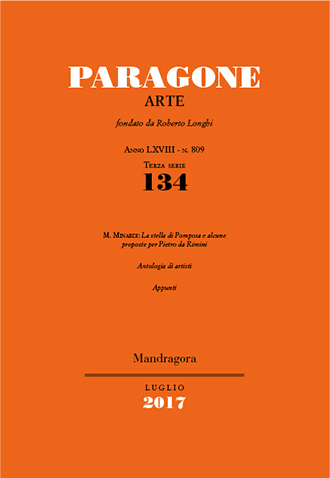Paragone Arte 134

Anno LXVIII – Terza serie – Numero 134 (809) Luglio 2017
Mauro Minardi: La stella di Pomposa e alcune proposte per Pietro da Rimini
ANTOLOGIA DI ARTISTI
From Florence to Brussels: Drawings by Francesco Petrucci (Catherine Phillips)
APPUNTI
Due disegni di Giulio Parigi per gli allestimenti fiorentini del 1608 (Stefano Rinaldi)
SUMMARY
MAURO MINARDI
The Cross by Pietro da Rimini now in Urbania Cathedral, one of the landmarks of Giotto-inspired Riminese Trecento painting, is usually regarded as the result of local Franciscan patronage. A re-examination of the work, distinguished by the presence of an eight-pointed gold star, and a study of archival documents, point to a link with the Abbey of Pomposa, which governed the churches of Sant’Angelo in Provenzo and Sant’Eracliano in the territory of Urbania. The work therefore appears to have had a different initial destination, and the author re-examines Pietro’s chronology during the 1320s, basing himself on comparison with less-studied paintings. The article concludes with evidence presented by two different Crosses, debated in both authorship and reconstruction: the first, putatively composed by uniting four fragmentary panels displayed in the Metropolitan Museum of Art in New York and the Walters Art Museum in Baltimore, probably consists of two separate, independent works; the second, housed in the Princeton University Art Museum, is in all likelihood a work by the Master of the Choir of Sant’Agostino, and reflects the evolution of Riminese painting during the 1320s, running parallel to the emergence of Pietro.
CATHERINE PHILLIPS
Francesco Petrucci (1660-1719), lavorò per Cosimo III de’ Medici e per il Gran Principe Ferdinando, ed ebbe ai suoi tempi una certa fama. I suoi disegni d’après dipinti, realizzati a chiaroscuro in penna e inchiostro marrone, acquerellati e tinteggiati di bianco, furono considerati come ‘quadri in carta’ autonomi. Un gran numero di questi disegni – che costituirono la base per le incisioni della raccolta medicea – appaiono nell’inventario post mortem dei beni di Ferdinando, ma data l’assenza di opere note non era stato ancora possibile valutare le qualità di un artista definito ‘bravissimo disegnatore’ dal Gabburri. L’articolo rende ora note venti opere inedite provenienti dalla collezione del Conte Karl Cobenzl, acquistate poi dalla zarina Caterina nel 1768 ed ora al Museo Statale dell’Ermitage a San Pietroburgo, così da stabilire un corpus certo di 33 disegni. Si forniscono, inoltre, le descrizioni di altri 28 fogli di collocazione ignota. Quasi tutti sono emersi sul mercato antiquario nella seconda metà del Settecento a Bruxelles. Non sappiamo come questi fogli abbiano lasciato Firenze, ma è probabile che a contribuire un qualche modo alla loro dispersione sia stato Ignazio Hugford.
STEFANO RINALDI
The author presents two little-known drawings by the Florentine architect and stage designer Giulio Parigi, connecting them with the ephemeral apparatus displayed during the marriage of Prince Cosimo de’ Medici to Maria Maddalena of Austria in 1608. The first sheet, an unpublished pen and ink drawing in an unknown location, is a scenery sketch for the fourth intermezzo of the pastoral comedy Il giudizio di Paride (The Judgement of Paris) by Michelangelo Buonarroti the Younger, with a representation of L’Arrivo di Amerigo Vespucci nel Nuovo Mondo (The Arrival of Amerigo Vespucci in the New World). The second drawing, housed in a private collection, shows a raft and fluvial allegories; it is proposed here that this was a sketch for the Argonautica, a complex costumed naval spectacle held on the Arno on the same occasion. The two drawings cast new light on the elaborate designs for the stagings of 1608, providing striking examples of Parigi’s graphic versatility.
